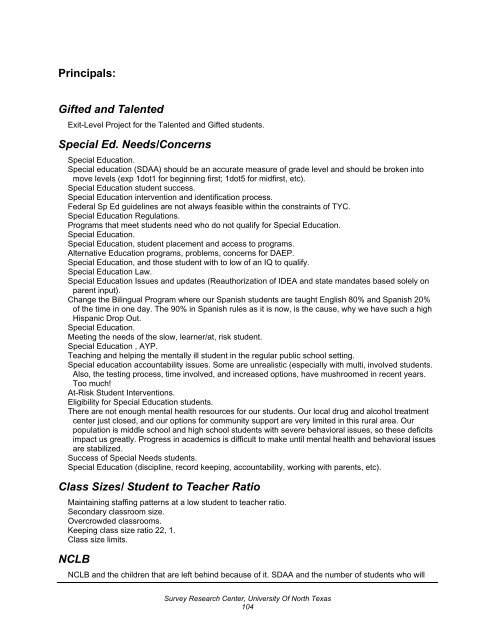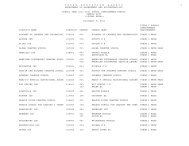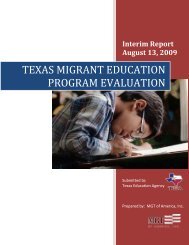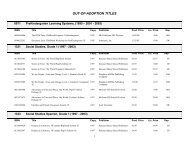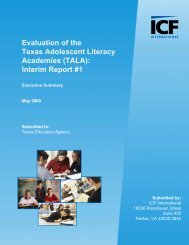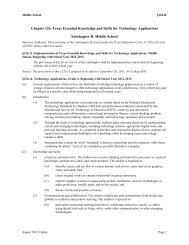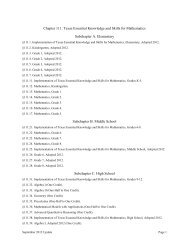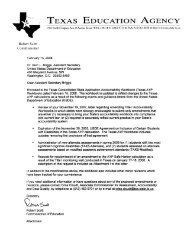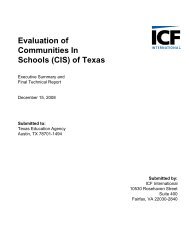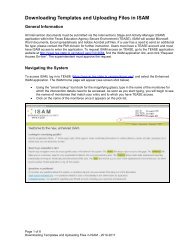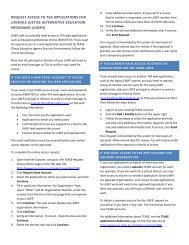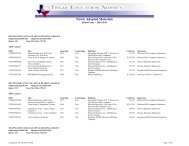2004 Customer Satisfaction Survey (PDF, 566 KB) - TEA - Home ...
2004 Customer Satisfaction Survey (PDF, 566 KB) - TEA - Home ...
2004 Customer Satisfaction Survey (PDF, 566 KB) - TEA - Home ...
You also want an ePaper? Increase the reach of your titles
YUMPU automatically turns print PDFs into web optimized ePapers that Google loves.
Principals:<br />
Gifted and Talented<br />
Exit-Level Project for the Talented and Gifted students.<br />
Special Ed. Needs/Concerns<br />
Special Education.<br />
Special education (SDAA) should be an accurate measure of grade level and should be broken into<br />
move levels (exp 1dot1 for beginning first; 1dot5 for midfirst, etc).<br />
Special Education student success.<br />
Special Education intervention and identification process.<br />
Federal Sp Ed guidelines are not always feasible within the constraints of TYC.<br />
Special Education Regulations.<br />
Programs that meet students need who do not qualify for Special Education.<br />
Special Education.<br />
Special Education, student placement and access to programs.<br />
Alternative Education programs, problems, concerns for DAEP.<br />
Special Education, and those student with to low of an IQ to qualify.<br />
Special Education Law.<br />
Special Education Issues and updates (Reauthorization of IDEA and state mandates based solely on<br />
parent input).<br />
Change the Bilingual Program where our Spanish students are taught English 80% and Spanish 20%<br />
of the time in one day. The 90% in Spanish rules as it is now, is the cause, why we have such a high<br />
Hispanic Drop Out.<br />
Special Education.<br />
Meeting the needs of the slow, learner/at, risk student.<br />
Special Education , AYP.<br />
Teaching and helping the mentally ill student in the regular public school setting.<br />
Special education accountability issues. Some are unrealistic (especially with multi, involved students.<br />
Also, the testing process, time involved, and increased options, have mushroomed in recent years.<br />
Too much!<br />
At-Risk Student Interventions.<br />
Eligibility for Special Education students.<br />
There are not enough mental health resources for our students. Our local drug and alcohol treatment<br />
center just closed, and our options for community support are very limited in this rural area. Our<br />
population is middle school and high school students with severe behavioral issues, so these deficits<br />
impact us greatly. Progress in academics is difficult to make until mental health and behavioral issues<br />
are stabilized.<br />
Success of Special Needs students.<br />
Special Education (discipline, record keeping, accountability, working with parents, etc).<br />
Class Sizes/ Student to Teacher Ratio<br />
Maintaining staffing patterns at a low student to teacher ratio.<br />
Secondary classroom size.<br />
Overcrowded classrooms.<br />
Keeping class size ratio 22, 1.<br />
Class size limits.<br />
NCLB<br />
NCLB and the children that are left behind because of it. SDAA and the number of students who will<br />
<strong>Survey</strong> Research Center, University Of North Texas<br />
104


